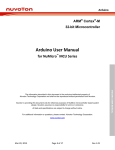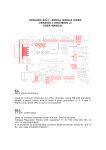Download Page!2!of!24"! Do : Don`t: Page!23!of!24"! How to connect? Output
Transcript
! ! Do : How to connect? • • • • • • • Be gentle while handling the board Power ON the board ONLY after making the complete connection. Keep the board on a dry surface. Use RED wire for 5V [+ve] and BLACK wire for GND[GROUND –ve] in experiments for better clarity See the complete circuit once before starting the experiment. Read about the components before using them in experiments Check your connections TWICE before powering ON the board Don’t: • • • • • Spill any liquid on board. Always keep it dry. Never drop the board. Components will be damaged. Never connect +ve to GND or –ve to 5V of any component. Turn the POT knob slowly and carefully. Never change any or make new connections when power [GREEN light] is ON. Output: • The two LEDs turn ON and turn OFF with some amount of delay. Observation: • Can you change the duration for which led flashes? More Details at: www.scienceadda.com/hobbyzone/electronics/led_flasher ©"2012!! www.scienceadda.com! Page!2!of!24"! ©"2012!! www.scienceadda.com! Page!23!of!24"! ! ! User Manual Notes: Jump Start Board Power!Switch! Components on board: • • • • • • • • • • • • ©"2012!! www.scienceadda.com! Page!24!of!24"! Diodes – 3 nos DIP switch – 4 nos RGB LED – 1 no Potentiometers – 8 nos Electrolytic Capacitors – 13 nos Light Sensor (LDR) – 1 no Sound Sensor – 1 no Transistors – 6 nos Switches – 4 nos IC slot – 1 nos Colour LED – 8 nos Connecting Terminal – 2 nos ©"2012!! www.scienceadda.com! Page!1!of!24"! ! ! • Make the connections of the experiment. Check your connections twice and press the Power supply switch. The Green Light indicates board is powered and you can check your output. Output: • The intensity of the RGB LED changes when the 1K POT is varied. Observation: ACTION OUTPUT Change the POT for Red, Green and Blue More Details at: www.scienceadda.com/hobbyzone/electronics/rgbLed ©"2012!! www.scienceadda.com! Page!4!of!24"! ©"2012!! www.scienceadda.com! Page!21!of!24"! ! ! Experiment 07 - LED FLASHER Getting started with board: Powering ON: How it works? • Connect the DC Adapter to the board as shown. • Power ON the Adapter. The RED light indicates power ON A simple pair of resistor and capacitor when connected in a specific manner creates a time delay in the path of the electricity. If this delay has to be repeated to blink an LED, a set of two such pairs are needed. Such a circuit can be seen at railroad signals, blinking rear light for bicycles, decorations, etc. What do you need? • Board • 2 x 330 ohm resistors – ( | | | ) Orange Orange Brown • 2 x 10k ohm resistors – ( | | | ) Brown Black Orange • 2 x 100uF capacitors (already on board) • 2 x BC547 transistors (already on board) • 2 x LEDs (any colour) Caution 1. Capacitors have polarity, i.e + (POSITIVE) and – (NEGATIVE) marked on them. 2. DO NOT connect 5V to NEGATIVE of the Capacitor or GND to POSITIVE of the Capacitor, it will explode. 3. Transistors have three pins – Emitter [E], Base [B] and Collector [C]. Connect them properly as shown in the wiring diagram. What to do? ©"2012!! www.scienceadda.com! Page!22!of!24"! ©"2012!! www.scienceadda.com! Page!3!of!24"! ! ! 2) Capacitor: How to connect? Capacitors are components that can store electrical pressure (Voltage) for long periods of time. It has polarity, i.e Positive and Negative terminal marked on its sides. 3) Potentiometer [POT]: Potentiometers are variable resistors. Turning the knob varies its resistance. 4) Light Dependant Resistor [LDR] [Light Sensor] LDR is a resistor which has high resistance normally and very low resistance when there is lots of light falling on it. Observation: 5) Diode: ACTION An electronic device that allows current to flow in one direction only. OUTPUT LDR covered in hands LDR in open Shine a torch directly on LDR 6) Transistors: A device that amplifies or switches the flow of current, between its terminals [Collector(c) and Emitter(e)]. The switching or amplification is controlled through Base [b] ©"2012!! www.scienceadda.com! More Details at: www.scienceadda.com/hobbyzone/electronics/Led_Ldr Page!6!of!24"! ©"2012!! www.scienceadda.com! Page!19!of!24"! ! ! Know your Component Experiment 06 – RGB LED Colour Mixer 1) Resistor: Why? Red, Green and Blue are the most basic colours. By mixing them in different proportions, we can get different colour output. In a TV screen, each point is similar to RGB led. By mixture of these three colours, it creates white, black, violet, pink and much more. Let us try it by mixing red, green and blue colours. The resistor is an electronic component that has electrical friction. It opposes the flow of electrons in the circuit. How it works? RGB led contains a red, a green and a blue led in a single pack. By using a pot, you can vary the resistance in the circuit, which results in varying intensity of the particular colour. What do you need? • Board • 3 x 330 ohm resistors – ( | | | ) Orange Orange Brown • 1 x RGB LED Caution! 3. RGB LED had 4 pins in which + pin goes to +5v and the rest 3 pins goes to 330 Ohms resistors. Example 1: What to do? The colours here are Yellow-Violet-OrangeGold. The value of the colours (refer to the table) are, yellow=4; violet=7; orange=3 [ignore gold] 47 X =47000Ω Or 47kΩ Example 2: The colours here are Brown-Black-Red-Gold. The value of the colours (refer to the table) are, Brown=1; Black=0; Red=2 [ignore gold] 10 X 102=1000 Ω or 1K Ω ©"2012!! www.scienceadda.com! Page!20!of!24"! ©"2012!! www.scienceadda.com! Page!5!of!24"! ! ! How to connect? How to read the Circuit Resistor LED +ve -ve Transistor: Switch Potentiometer [POT]: Light Sensor [LDR]: Capacitor Output: • The LEDs will turn ON and turn OFF based on pot value, turn the pot in clockwise and Anti-clockwise to make out the changes in the brightness of the LEDs. OUTPUT ACTION POT varied clockwise POT varied anti-clockwise More Details at: www.scienceadda.com/hobbyzone/electronics/led_pot ©"2012!! www.scienceadda.com! Page!8!of!24"! ©"2012!! www.scienceadda.com! Page!17!of!24"! ! ! Experiment 05 - Light Based LED Intensity 7) LED [Light Emitting Diode]: Why? Smart Street Lights will turn ON during night times and turn OFF during the day automatically. These lights use a LIGHT SENSOR called LIGHT DEPENDANT RESISTOR [LDR]. Try a simple experiment using a LDR in the board and record the output. How it works? As light falling on the LDR increases, its resistance decreases. As a result more current flows through the LED, increasing its brightness. A device which emits light when powered ON. It is available in various colours. As it is a diode, it works only in one direction. It has polarity, so 8) Switch: A mechanical device which opens or closes a circuit. It is used to turn ON or turn OFF Lights and speakers. When you cover the LDR, its resistance increases. So due to high resistance, brightness of the LED reduces. What do you need? • Board • 1 x LDR [LIGHT SENSOR] • 1 x LED (any color) What to do? ©"2012!! www.scienceadda.com! Page!18!of!24"! ©"2012!! www.scienceadda.com! Page!7!of!24"! ! ! Experiment 04 – LED Intensity using Potentiometer box!1! Why? When you want to control the flow of water in two different pipes, you will use a master tap and regulate the flow. You can let more water through tap1 and less through tap2. Let us try something similar. box!2! How to connect? How it works? Intensity of LED1 and LED2 changes on turning the Pot Knob. When the resistance varies, the LED with least resistance in its path glows with more brightness. What do you need? • Board • 1 x 330 ohm resistors – ( | | | ) Orange Orange Brown 2 x LED (any color) • 1 x 1K pot CAUTION: • Handle the POT very carefully using hands. • Don’t use sharp objects to turn the POT • Do NOT move the POT beyond the given limit as shown below. Output: • • The LED turns ON when two wires are touched with hands. Observation: ACTION OUTPUT Wire touched with hands NORMAL POSITION Wire touched with shade no 1 Wires touched with shade no 2 More Details at: www.scienceadda.com/hobbyzone/electronics/led_touch ©"2012!! www.scienceadda.com! Page!10!of!24"! ©"2012!! www.scienceadda.com! Page!15!of!24"! ! ! Experiment 01 – LED Control with Touch and Graphite Anti -Clockwise MAXIMUM Why? How does resistance change with length and width of a conducting body? Does human body offer resistance? Let us find out. How it works? Clockwise MAXIMUM The human body is very much like a thin rubber bag full of salt water. By touching the wires the Circuit will be closed and thereby causing the LED to GLOW. Also shade the box given using pencil and make the wires touch its end and observe the change. What do you need? What to do? • Board • 1 x 330 ohm resistors – ( | | | ) Orange Orange Brown • 1 x BC547(NPN) transistors (already on board) • 1 x LED (any colour) Caution 1. Transistors have three pins – Emitter [E] , Base [B] and Collector [C]. Connect them properly as shown in the wiring diagram. What to do? ©"2012!! www.scienceadda.com! Page!16!of!24"! ©"2012!! www.scienceadda.com! Page!9!of!24"! ! ! Experiment 03 – AND GATE Why? Switches are used to open or close a circuit. Here we work on an AND GATE, where when only both the switches are pressed, the light glows. You can implement a circuit with multiple switches for a single light where until the main switch is ON, the light will not turn ON. How it works? When the mains are turned OFF in your home, none of the switches will be able to turn ON fans or TV. Here the MAIN switch is the master and other switches are slaves. Only when the master switch is ON, slave switches can function. Let us try an experiment on this. What do you need? • Board • • 1 x LEDs (any colour) Caution! Output: • 1 x 330 ohm resistors – ( | | | ) Orange Orange Brown The LED will turn ON if any one switch is pressed or even if both switches are pressed. 2. LED`s have polarity connect the +VE terminal to 330 Ohm resistor and negative to ground. What to Do? Observation: OUTPUT ACTION S1 and S2 both pressed Only S1 is pressed Only S2 is pressed More Details at: www.scienceadda.com/hobbyzone/electronics/or_gate ©"2012!! www.scienceadda.com! Page!12!of!24"! ©"2012!! www.scienceadda.com! Page!13!of!24"! ! ! Experiment 2 – OR Gate [switch] Why? Switches are used to open or close a circuit. Here we work on an OR GATE, where if any of the switch is pressed, the light glows. You can implement a circuit with multiple switches for a single light. If there is a single bulb in a corridor, you can use OR Gate to control it from two different switches in different places. How it works? A simple pair of switch (S1 & S2) and a resistor when connected to a LED as shown creates an OR GATE. Here when any of the switch is pressed, it closes the circuit and LED turns ON. What do you need? • Board • 1 x 330 ohm resistors – ( | | | ) Orange Orange Brown Output: • • 1 x LED (any colour) The LED turns ON only when both the switches S1 & S2 are pressed together. Observation: Caution 1. LED`s have polarity connect the +VE terminal to 330 Ohm resistor and negative to ground. OUTPUT ACTION What to Do? S1 and S2 both pressed Only S1 is pressed Only S2 is pressed More Details at: www.scienceadda.com/hobbyzone/electronics/and_gate ©"2012!! www.scienceadda.com! Page!14!of!24"! ©"2012!! www.scienceadda.com! Page!11!of!24"!

























